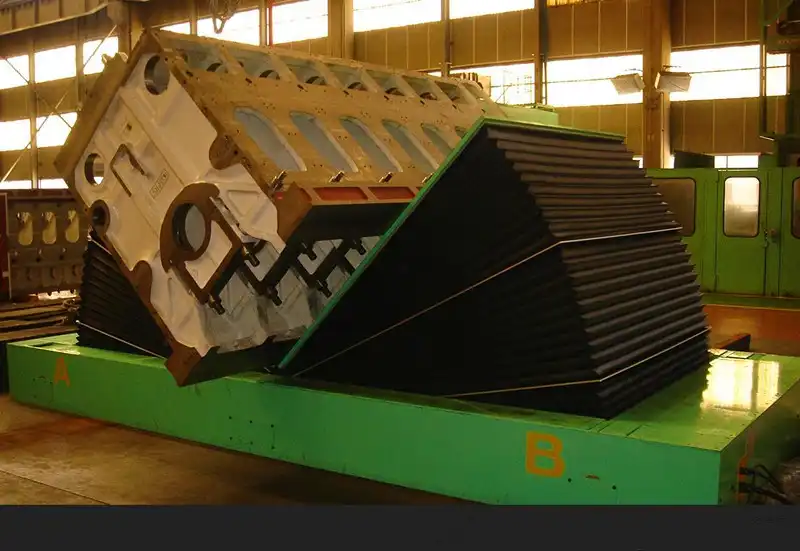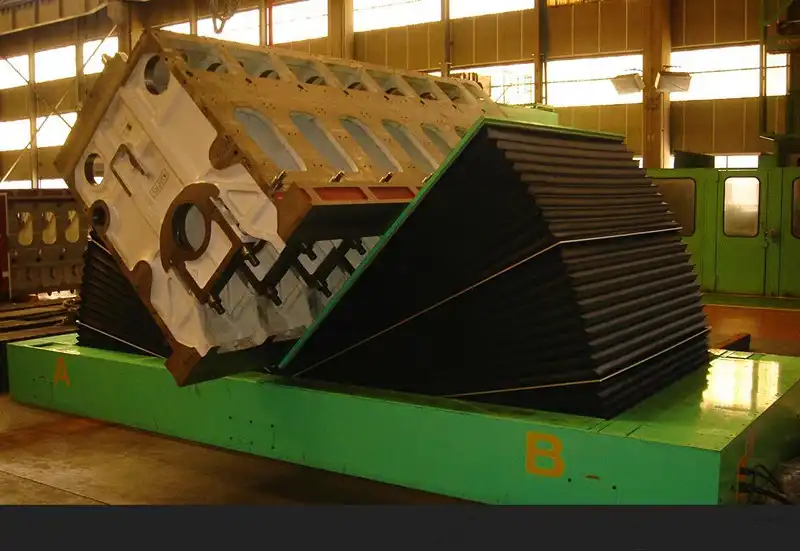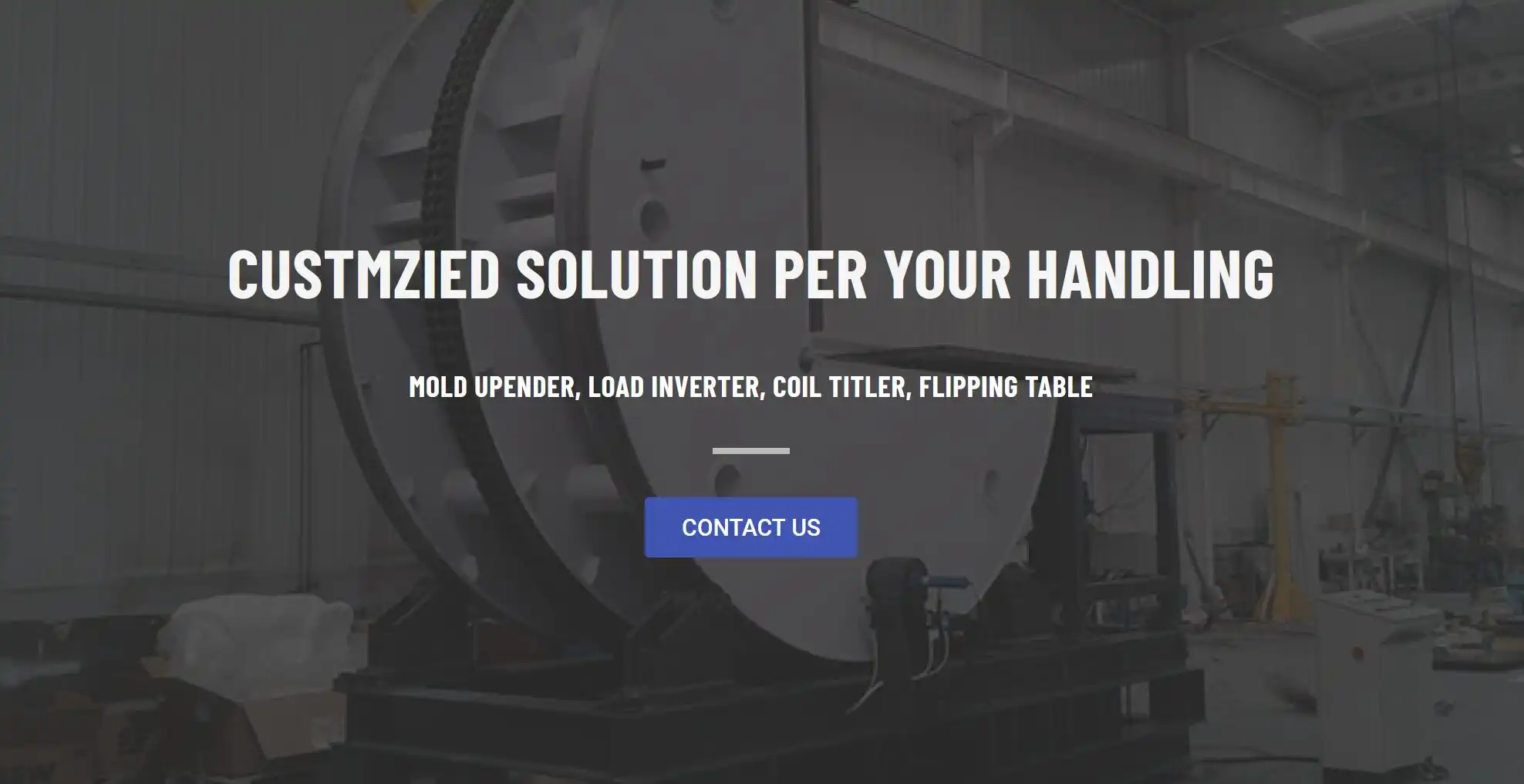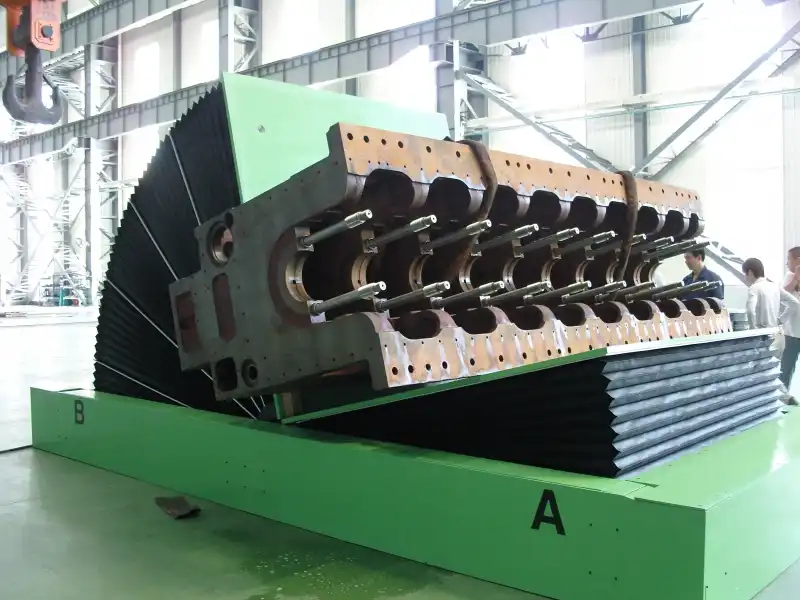Mold Flipper: Can a Pit-less Design Simplify Installation in Thai Workshops?
Installing heavy machinery in a busy workshop is always a challenge. When it comes to a mold flipper, the traditional approach often involves major civil engineering work. You have to think about digging a deep pit, pouring reinforced concrete, and dealing with potential groundwater issues. This process is not just expensive; it’s incredibly disruptive to your operations. In a place like Thailand, where workshop space is valuable and construction can face unique logistical hurdles, these disruptions can cause significant delays and budget overruns. The dust, noise, and downtime can bring a section of your plant to a complete standstill, affecting production schedules and your bottom line. What if there was a way to get the same heavy-duty performance without turning your factory floor into a construction site?
Yes, a pit-less mold flipper design can significantly simplify installation in Thai workshops by eliminating the need for costly and time-consuming civil works like digging a pit. This leads to faster deployment, lower initial costs, and greater layout flexibility for future adjustments.

So, we have established that a pit-less design is simpler. But this statement goes much deeper than just avoiding a hole in the ground. What does this "simplicity" truly mean for your operational efficiency, your workers' safety, and your long-term financial planning? The benefits extend far beyond the initial installation phase. Let's dig into the details and explore how this design choice can be a strategic advantage, starting with the surprising costs you might not have considered with traditional pit-mounted machines.
When you receive a quote for a new piece of equipment, it's easy to focus on the price of the machine itself. But for a pit-mounted mold flipper, that number is just the beginning of the story. Have you fully accounted for everything that goes into creating a massive, permanent hole in your factory floor? The real investment is often hidden in the line items for civil works, project management, and operational downtime. These hidden expenses can quickly inflate the total project cost, turning a seemingly reasonable purchase into a major capital expenditure. It's a classic trap that I've seen many factory managers fall into, and it highlights the importance of looking at the total cost of implementation, not just the equipment tag.
The hidden costs of a traditional pit-mounted mold flipper include extensive civil engineering, excavation, foundation work, drainage systems, extended project management, and significant production downtime during installation. These can often exceed the cost of the machine itself.

Diving Deeper into Total Cost of Ownership
From my years as an engineer and later as a factory owner, I’ve learned that the true cost of any machine is measured over its entire lifecycle. A pit-mounted flipper is a prime example of how initial, indirect costs can have a long-lasting impact. Let's break them down.
Direct Civil Engineering Costs
This is the most obvious category of hidden costs, but its scope is often underestimated. It's not just about hiring a team to dig a hole.
- Geotechnical Survey: Especially in regions like Thailand, you may need a soil analysis to determine stability and check the water table. A high water table complicates everything.
- Engineering Plans: You need certified architectural and engineering drawings for the pit itself, detailing reinforcement, concrete specifications, and drainage.
- Excavation and Debris Removal: The cost to dig, and then to haul away tons of soil and concrete, adds up.
- Foundation Work: This involves laying rebar, pouring high-strength concrete, and allowing for curing time, which can take weeks.
- Waterproofing and Drainage: If there's any risk of groundwater ingress, you'll need expensive waterproofing membranes and potentially a sump pump system, which adds an ongoing energy and maintenance cost.
I remember a client in Rayong, Thailand. They had a quote for a German-made pit-mounted flipper that seemed competitive. But during the planning phase, the survey revealed a high water table. The requirements for a fully waterproof, specially reinforced pit with a permanent drainage system more than doubled the installation budget. It was a major setback that forced them to reconsider their entire plan.
Indirect Operational and Long-Term Costs
These costs are less tangible but can be even more damaging.
| Cost Factor | Pit-Mounted Flipper Impact | Pit-Less Flipper Impact |
|---|---|---|
| Production Downtime | High. The installation area is a no-go zone for weeks, disrupting workflow. | Low. Machine is placed, anchored, and connected in a matter of days. |
| Project Management | High. Requires coordination between machine supplier, civil engineers, and construction crews. | Low. Primarily involves the machine supplier and your own maintenance team. |
| Workshop Flexibility | None. The pit is a permanent fixture, locking in your layout. | High. The machine can be moved with a heavy forklift to optimize workflow later. |
| Future Decommissioning | Very High. The pit must be safely filled in, which is another construction project. | Low. The machine is simply disconnected and removed. |
The inflexibility is a strategic cost that many leaders, like Javier, rightly worry about. The needs of a factory change. In five years, you might want to rearrange your entire production line to improve efficiency. A permanent pit is a massive anchor holding you back from that kind of agility.
How does a pit-less flipper improve workshop safety and flexibility?
A workshop floor is a dynamic environment. People, forklifts, and materials are in constant motion. In this setting, any permanent obstacle or hazard creates a persistent risk. An open or even a covered pit for a mold flipper is a textbook example of such a hazard. It's a place where someone can trip and fall, where tools can be dropped, and where cleaning becomes complicated. Beyond the immediate safety concerns, a pit imposes a rigid structure on your workspace. It dictates your layout for years to come. What happens when your business grows and you need to optimize your production flow? That permanent hole in the ground becomes a major obstacle to progress and efficiency.
A pit-less flipper improves workshop safety by eliminating the open pit, which is a significant trip and fall hazard. It enhances flexibility by allowing the machine to be easily relocated, enabling dynamic changes to the workshop layout without the constraints of a permanent concrete structure.

Diving Deeper into a Safer, More Agile Workspace
When I transitioned from being an employee to running my own factory, my perspective on workshop design changed. I wasn't just thinking about the machine; I was thinking about the people and the process. Safety and efficiency became my top priorities, and this is where the pit-less design really shines.
Enhancing Worker Safety
The most direct benefit is the elimination of the pit itself. Pits are a constant source of concern for any safety manager.
- Trip and Fall Hazards: Even with guardrails or covers, the risk of a misstep is always present. A pit-less flipper sits on a flat plane with the rest of the workshop floor, removing this fundamental danger.
- Confined Space Issues: Maintenance or cleaning inside a pit often requires confined space entry permits and procedures, adding complexity and risk. With a pit-less design, all components are in the open.
- Improved Housekeeping: Pits inevitably collect oil, coolant, dirt, and debris. This creates a slippery, dirty environment that is difficult to clean. A pit-less machine allows for easy cleaning around and under the unit, promoting a safer, more organized workspace. This aligns directly with 5S and other lean manufacturing principles.
The Strategic Value of Workshop Flexibility
This is a point that forward-thinking leaders like Javier, who are focused on long-term strategy, will appreciate. The modern manufacturing environment demands agility.
- Support for Lean Manufacturing: Lean principles are all about optimizing flow and eliminating waste. If you discover a bottleneck, you need the ability to rearrange your process. A pit-less flipper can be moved with a heavy-duty forklift or crane in a day. A pit-mounted machine locks you into a potentially inefficient layout forever.
- Adapting to New Product Lines: Imagine you win a contract for a new type of product that requires a different production sequence. The ability to relocate your mold handling equipment without a major construction project gives you a significant competitive advantage.
- Future-Proofing Your Investment: You are not just buying a machine; you are investing in a capability. A mobile capability is far more valuable than a fixed one.
I worked with a steel service center that illustrates this perfectly. They initially placed their flipper at the end of their main slitting line. A couple of years later, they invested in a new stamping press and realized a completely different workflow would be more efficient. Because they had chosen a pit-less model, the relocation project was straightforward. They spent a weekend moving the flipper and some other equipment. If it had been in a pit, they would have been forced to either live with a suboptimal layout or spend a huge amount of money building a second flipper station. Their initial choice gave them the freedom to adapt and grow.
Is a pit-less design suitable for heavy-duty applications like in steel mills?
When you are dealing with molds, dies, or steel coils that weigh many tons, stability is non-negotiable. This is a primary concern for anyone in the steel industry, like Javier. There's a natural assumption that anchoring a machine in a concrete pit makes it stronger and more stable. The image of a machine that simply sits on the floor handling a 30-ton load can seem counterintuitive. You might worry that a pit-less design could vibrate excessively, be less secure, or simply not be robust enough for the relentless, 24/7 environment of a steel mill. This doubt can lead you to stick with the traditional pit-mounted approach, even if you know it's more expensive and less flexible.
Yes, a pit-less mold flipper is perfectly suitable for heavy-duty applications like in steel mills. They are engineered with robust frames, powerful hydraulic or electromechanical systems, and a low center of gravity to safely and reliably handle massive loads, often up to 50 tons or more, without requiring a pit.

Diving Deeper into Heavy-Duty Engineering
The question of strength and stability is one I take very seriously as an engineer. The belief that a pit is necessary for heavy loads is a misconception rooted in older design philosophies. Modern engineering has solved this problem effectively.
The Engineering Behind the Strength
A well-designed pit-less flipper achieves stability through intelligent design, not just brute anchoring.
- Wide and Heavy Base Frame: The machine's footprint is engineered to be wide and constructed from thick, heavy-gauge steel. This creates an incredibly stable base that distributes the load over a large surface area.
- Low Center of Gravity: The heaviest components, like the main drive systems and structural supports, are positioned as low as possible. When the machine tilts a heavy load, the combined center of gravity remains safely within the machine's base, preventing any risk of tipping.
- Robust Drive Systems: We use oversized hydraulic cylinders or powerful electromechanical gear motors. These systems are designed for smooth, controlled motion, avoiding the sudden jerks that can cause instability. The focus is on controlled power, not just raw force.
Load Distribution and Floor Requirements
A pit-less design doesn't mean you can place it anywhere. It relies on a standard, solid industrial foundation, which most modern workshops in Thailand and elsewhere already have.
- Floor Loading: The key is to ensure your concrete floor slab can support the combined weight of the machine and its maximum load. A standard 6-8 inch (150-200 mm) reinforced concrete slab, common in industrial buildings, is typically more than sufficient.
- Verification: Before I sell any heavy-duty machine, I ask the client for their floor specifications. We can easily calculate the point loading to ensure it is well within the floor's capacity. This is a simple but critical step that ensures safety and performance.
When I established my own factory, this was a critical decision point for me. We handle large steel coils and heavy machine components. We opted for a 20-ton capacity pit-less flipper. The key was ensuring our foundation was up to spec during construction. That machine has been a workhorse for us, operating daily for years without a single issue related to stability. The stability comes from the machine's engineering, not from being sunk into the ground.
| Stability Factor | Pit-Mounted Flipper | Pit-Less Flipper |
|---|---|---|
| Foundation Type | Deep, reinforced concrete pit | Standard 150mm+ industrial slab |
| Stability Mechanism | Anchored into dedicated pit walls | Wide, heavy base frame design |
| Vibration Damping | Relies on mass of pit structure | Integrated into heavy frame and quality components |
| Load Capacity | Very High | Very High (Engineered to match specific needs) |
For any factory owner, the proof is in the performance. Pit-less designs are proven workhorses in the most demanding industries, including steel mills, die casting plants, and heavy manufacturing facilities worldwide.
What are the key maintenance differences between pit and pit-less mold flippers?
Every machine requires regular maintenance to ensure a long and productive life. But the ease and safety of performing that maintenance can vary dramatically. With a traditional pit-mounted flipper, many of the most critical components—hydraulic pumps, motors, bearings, and hoses—are located down in a dark, cramped, and often dirty pit. This location presents a significant challenge for your maintenance team. It makes simple inspections difficult and turns minor repairs into complex, time-consuming jobs. The environment itself can accelerate wear and tear, hiding problems until they become critical failures. This is a direct threat to your goal of maximizing uptime.
The key maintenance difference is accessibility. Pit-less mold flippers offer 360-degree access to all major components like motors, hydraulics, and bearings at floor level. This simplifies inspection, cleaning, and repairs, unlike pit-mounted units where components are in a confined, hazardous space.

Diving Deeper into Maintenance and Uptime
As someone who has spent countless hours on the factory floor, I can tell you that a machine that is easy to maintain is a machine that gets maintained properly. This is where the pit-less design provides a massive operational advantage, directly impacting reliability and your total cost of ownership (TCO). This is critical for achieving goals like 95% equipment uptime.
Accessibility and Proactive Maintenance
The core benefit is open access.
- Easy Inspections: Your team can walk around the entire machine and easily see everything. They can spot a leaking hydraulic hose, check gearbox oil levels, or listen for an unusual bearing noise without needing special equipment or procedures. This encourages frequent, proactive checks.
- Predictive Maintenance: For a leader like Javier, who is pushing for digitalization, this is key. Installing IoT sensors to monitor vibration, temperature, or hydraulic pressure is simple on a pit-less machine. On a pit-mounted unit, sensors are in a harsh, wet environment, and wiring can be complex. Easy access facilitates the move toward data-driven, predictive maintenance.
- Faster Repairs: When a repair is needed, the time savings are enormous. Components are accessible. A mechanic isn't working on their back in a dirty pit. This reduces Mean Time To Repair (MTTR), a critical metric for any plant manager.
The Pitfall of the Pit: Common Maintenance Headaches
The pit itself creates problems.
- Confined Space Entry: This is a major safety and administrative burden. It requires permits, air quality monitoring, and a standby person. A simple 30-minute inspection can turn into a half-day procedure.
- Water and Debris: Pits are natural collection points for water, oil, metal shavings, and other debris. This creates a corrosive sludge that can damage components and hide developing problems.
- Poor Ergonomics: Working in a cramped, poorly lit pit is physically demanding and increases the risk of injury for your maintenance staff.
| Maintenance Task | Pit-Mounted Flipper | Pit-Less Flipper |
|---|---|---|
| Daily Visual Inspection | Difficult, requires looking down into a dark pit. | Simple, 360-degree walk-around at floor level. |
| Hydraulic System Check | Requires pit entry, poor lighting and access. | Easy, all components are accessible in the open. |
| Cleaning the Machine | Extremely difficult. The pit acts as a trap. | Straightforward. Can sweep or wash around the unit. |
| Component Replacement | Complex. Often requires rigging to lift parts out of the pit. | Simple. Direct access for forklifts or overhead cranes. |
Ultimately, a machine that is easier to maintain will last longer and run more reliably. By choosing a pit-less design, you are not just simplifying installation; you are investing in higher uptime and a lower total cost of ownership for the entire life of the machine.
Conclusion
A pit-less mold flipper simplifies installation, enhances safety, and lowers long-term costs. It is a modern, flexible, and robust solution for any workshop, including demanding steel mills.





